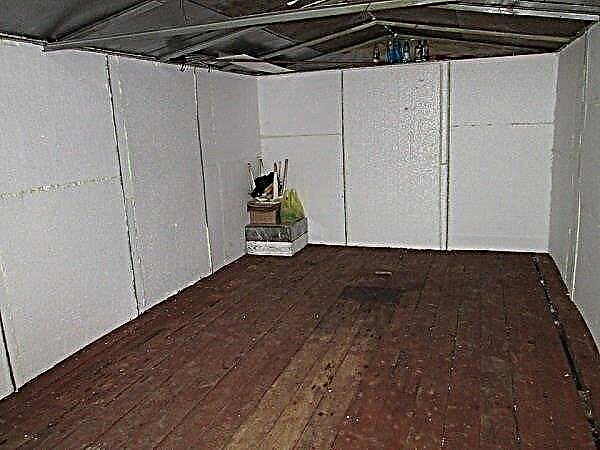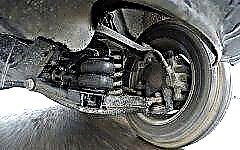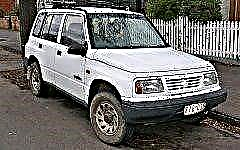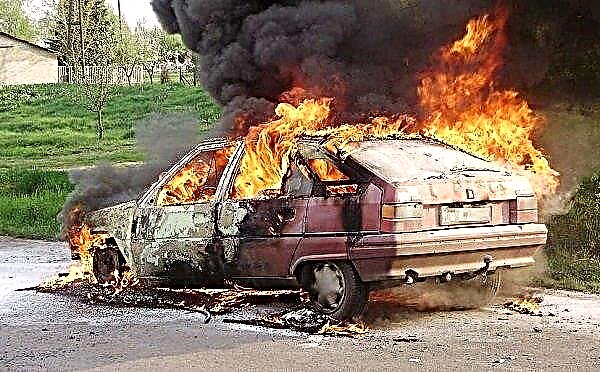
The content of the article:
- Causes of fire
- Internal reasons
- External causes
- How to keep your car from catching fire
- What to do in case of fire
- How to choose a fire extinguisher
Fire safety in a car depends almost entirely on the skills and knowledge of the driver. Every car owner should have a clear idea of how to prevent a fire in the car, what measures to take in case of fire and, ideally, be able to provide first aid to victims.
Causes of fire
A fire can be triggered by many factors, from a cigarette butt lying between the seats to a malfunction in the engine compartment. Let's look at the main reasons why fires in cars happen most often. These are, first of all, internal causes associated with malfunctions of automotive systems.
Internal reasons

Fuel leak
The most common cause of fire. If the car smells of fuel, then the only correct solution in this situation is to find and fix the problem. Right now. Because in some cases, in order to provoke a fire, even no external influence is needed - ignition can occur by itself. Gasoline, for example, ignites spontaneously when heated to 257 degrees Celsius; also a spark at a temperature of 7.2 degrees is enough for him.
Gas cars are safer in this regard, but not completely. A small concentration of gas in the area of the gearbox - and a fire is ready to break out at any moment.
Faulty electrical system
Reason # 2 in popularity. Batteries are quite complex and full of surprises - for example, they can emit explosive gases, for which only worn-out wiring is enough to ignite. Moreover, a fire can occur not only in the area of the engine, but also "on the territory" of the entire car.
This also includes malfunctions with electrical appliances and their incorrect installation.
Leakage of flammable liquids
These include:
- fuel;
- engine oil;
- transmission fluid;
- brake;
- cooling;
- power steering fluid.
All this explosive mixture is not only present in the engine compartment, but also "wanders" throughout the car. The slightest damage to the hose and leaks are guaranteed. And one single spark will complete what it started.
Overheating of the engine
An overheated motor itself is not so dangerous, but its temperature affects the operation and the state of other components - the temperature of the oil (coolant) rises, they begin to seep out, fall on the heated parts of the system, and then a fire is only a matter of time.
Exhaust catalyst overheating
When it comes to the causes of car fires, it is mainly the propulsion and fuel systems that come to mind, but the exhaust system is most often overlooked. However, an excessive load on the filter neutralizer leads to overheating and, as a result, a fire, which, in turn, can cause a fire in the passenger compartment.
The neutralizer filters exhaust gases, removing toxic and environmentally hazardous substances from them. If these substances are concentrated in a larger amount (for example, due to improper engine operation) than the converter can process, then it overheats.
Unscrupulous maintenance
And the point here is not even in the marriage of the master's work, but, most often in ordinary carelessness. During the inspection, the wear of the engine gasket may not be noticed (it seems such a trifle), and as a result - a leak of a flammable liquid. And what it is fraught with, we have already considered.
Manufacturer's fault
This can be either a one-time mistake or a serial marriage. Almost every auto concern has ever faced the need to recall a series of produced cars from the market, due to a constructive error. For example, Ford released a series of cars with a dangerous flaw in the fuel system, which increased the risk of car fires several times.
In addition to the internal reasons, hidden in the car itself, there are also external ones.
External causes of a car fire

Crash
In the event of an accident, be it a serious collision or a simple fall into a ditch, the machine should be carefully checked for all of the above (and not only) causes of fire. Even if at first glance everything is in order with the car and there seems to be enough cosmetic repairs, one should not forget that a damaged wiring and a crack in the fuel hose are enough for a fire to occur.
Intentional arson
As silly as it may sound, setting fire to someone else's car is not uncommon. There are many reasons for this behavior, ranging from personal hostility towards the owner of the car and ending with attempts to cheat on insurance. This also includes fans of vandalism, cars and monuments - their favorite targets.
Unextinguished cigarette
It is worth putting in the cabin a roomy ashtray with high sides and using it.
Many drivers and passengers in the process of driving have a habit of throwing open cigarette butts out the window. First, a cigarette thrown into the front door window can fly into the passenger compartment of the same car if the rear door window is open. Secondly, a similar thing can happen in relation to cars going behind.
A cigarette butt forgotten or accidentally abandoned in the cabin will, at best, burn through the seat upholstery; at worst, the entire cabin will burn out. And if it suddenly turns out to contain a container with some easily flammable liquid (a spare can of gasoline that did not fit in the trunk, for example), then the consequences are easy to imagine.
How to keep your car from catching fire

A number of preventive measures taken by the car owner will allow, if not to fully protect themselves and the car, then to minimize the risk and damage caused.
What will help you avoid trouble:
- Regular and timely maintenance. If the car runs on gas, regular checks are also required in the special. workshop.
- Competent installation of electronics (radio, alarm, on-board computer). If you are not sure that you can correctly replace / install an electrical appliance, you should contact a specialist - wiring is the most vulnerable point of fire safety.
- Regular checks of the condition of electrical equipment.
- Regularly check the gas tank and other containers with flammable liquids for leaks.
- Transportation of spare fuel and lubricants in tightly closed and absolutely sealed containers; smudges are unacceptable.
- The presence of a working fire extinguisher in the cabin. Moreover, it is important not only to keep it in the car for fear of a fine, but also to be able to use it.
What to do in the event of a fire in a car

To get out of this situation with the least loss, you only need two things:
- do not give in to panic;
- learn to work with a fire extinguisher in advance.
A fire extinguisher does not exist to “exist”, but to use it if necessary. Therefore, you should study the instructions in advance; when smoke comes out from under the hood, there will be no time for reading.
What steps to take if the car catches fire
- Stop and switch off the engine.
- Put the car on the brake, block the wheels so that the car is in a fixed state.
- Help passengers get out, if any, and send them to a safe distance.
- Ask to call for help - an ambulance, technical assistance, a rescue team, the police. If there is no one nearby, call it yourself.
- When leaving the car, do not forget to take a fire extinguisher and a first aid kit with you.
- Put an emergency sign on the road.
- Try to extinguish the fire with a fire extinguisher. Sometimes it is advised to resort to the help of improvised means - sand, thick fabric, tarpaulin, water. Naturally, the use of "old-fashioned" methods is undesirable. Moreover, it can also be dangerous. For example, water or sand in the engine compartment can only exacerbate the situation. Not to mention that it will be difficult or even impossible to get rid of the consequences of such manipulations.
- If it is not possible to extinguish the fire, you should move to a safe distance (10 meters or more), otherwise you may suffer from an explosion in the fuel tank.
- If possible, you should secure nearby vehicles. This can be done by rolling them back with someone's help or by pouring water on them.
Putting out a fire - what you need to know
- If a fire has occurred in the vicinity of the fuel tank, the best solution is to move away from the vehicle as soon as possible and move everyone in the vicinity to a safe distance.
- In the event of a fire in the passenger compartment or engine compartment, you can try to extinguish the fire yourself. For this, a worker is needed, with an unexpired fire extinguisher.
- The influx of oxygen will provoke intense combustion, because the hood or the door of the passenger compartment cannot be opened completely, it is enough to open it a little so that you can direct the jet from the fire extinguisher.
- The duration of the fire extinguisher is about 1 minute on average. You need to remember this and try to spray its contents over the largest possible area.
- The jet from the fire extinguisher should first of all be directed to the place where the burning is most intense, then the periphery of the hearth should be treated.
- If a fire occurs in a garage, the vehicle should, whenever possible, be taken outside to prevent the fire from spreading to the structure.
How to choose a fire extinguisher for a car

There are three types of fire extinguishers, but only two of them are allowed to be used in vehicles. The principle of operation for both types (powder and carbon dioxide) is similar - an extinguishing agent (powder or carbon dioxide) supplied under pressure, falling on the fire site, prevents the access of oxygen, thereby reducing the fire to a minimum.
Powder fire extinguisher has a number of advantages:
- ease of use;
- security;
- low cost;
- light weight;
- versatility (suitable for extinguishing any kind of fire).
The disadvantages include:
- short service life (1.5 years), after which the powdery filler forms lumps, which affects the performance; replacement every one and a half years is required;
- does not cool the surface to be treated, as a result of which a fire may occur again;
- in the process of extinguishing, it forms powder "smoke", impairing the view.
Carbon dioxide fire extinguisher. Its advantages:
- surface cooling;
- long service life (5 years);
- versatility, etc.
This type of fire extinguisher has similar performance characteristics to the powder version, but has a significant drawback - it is dangerous to work with it. Some more disadvantages:
- Carbon dioxide, unlike powder, is supplied under the influence of low temperatures. On contact with human skin, it causes severe frostbite.
- Dangerous to the body if it enters the respiratory system. In large quantities, paralytic effects are possible.
The choice of a fire extinguisher by external characteristics
- It is advisable to choose a fire extinguisher with a metal body, it is much more reliable than similar plastic ones.
- The check must have a seal.
- Any fire extinguisher has instructions for use, stuck on the body and data sheet. You can also ask the seller to present a certificate for the goods.
- The mass of the contents (excluding the container) should not be less than 2 kg.
- Powder products are completed with a pressure gauge; if the fire extinguisher is functional, the arrow is located in the green zone.
Modern car models are less susceptible to the risk of fire, but this does not mean that this possibility can be completely ruled out. Careful attention to the car, timely identification and elimination of malfunctions, as well as the availability of a working fire extinguisher - all this will help to minimize not only the risk of damage to health, but also the material costs for the restoration or purchase of a new car.











